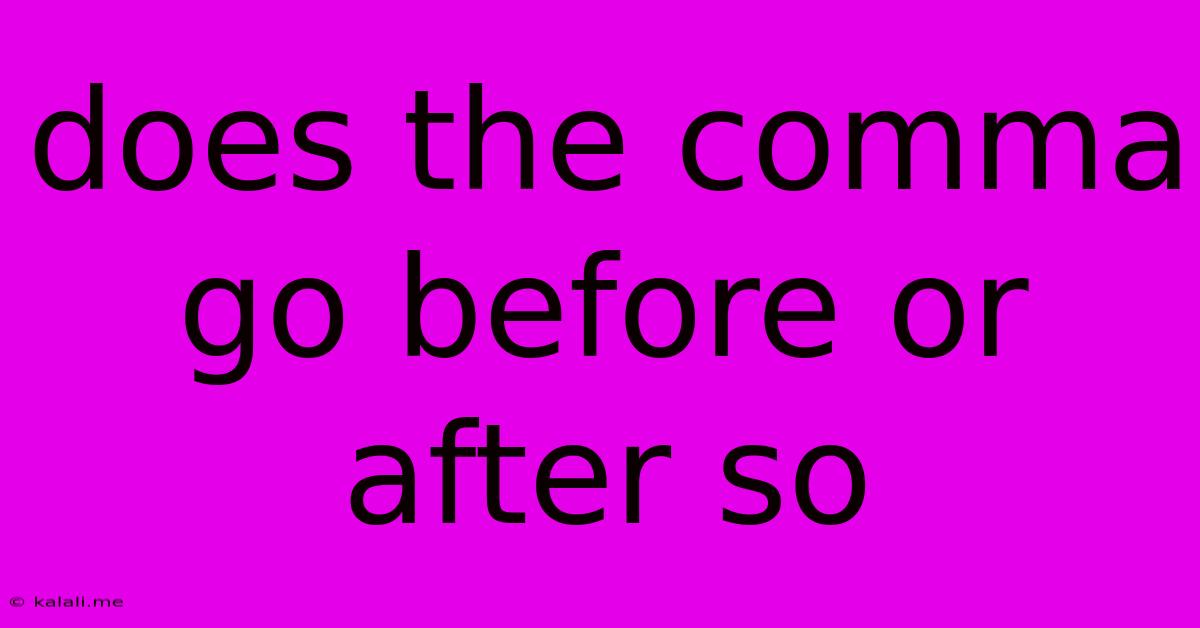Does The Comma Go Before Or After So
Kalali
Jun 02, 2025 · 3 min read

Table of Contents
Does the Comma Go Before or After "So"? A Comprehensive Guide
The placement of a comma before or after the conjunction "so" is a common grammar question. The answer, unfortunately, isn't a simple "always before" or "always after." The correct punctuation depends entirely on the context of the sentence and the role "so" plays within it. This article will clarify the rules and provide examples to help you master this punctuation point.
Understanding the Role of "So"
The word "so" can function in a few different ways in a sentence. Its function dictates whether a comma is needed. It can act as:
- An adverb: Indicating consequence or result. In this case, a comma usually precedes "so."
- A conjunction: Joining two independent clauses. A comma typically precedes "so" here, but it isn't always strictly required.
- An intensifier: Emphasizing a preceding word or phrase. No comma is generally needed.
1. "So" as an Adverb Indicating Consequence
When "so" introduces a consequence or result of a previous clause, it's usually preceded by a comma. This creates a clear separation between the cause and effect.
- Example: The rain was torrential, so we decided to stay inside.
In this sentence, "The rain was torrential" is the cause, and "we decided to stay inside" is the consequence. The comma before "so" signals this relationship. Other examples include:
- It was extremely cold, so I put on my coat.
- She was tired from the journey, so she went straight to bed.
2. "So" as a Conjunction Joining Independent Clauses
When "so" connects two independent clauses (each capable of standing alone as a complete sentence), a comma generally precedes it. This improves readability and clarity.
- Example: The movie was fantastic, so we all agreed to see it again.
Here, "The movie was fantastic" and "we all agreed to see it again" are both independent clauses. The comma before "so" helps avoid a run-on sentence. However, with shorter sentences, the comma might be omitted without causing confusion:
- I’m tired so I'll sleep. (Comma optional in this concise case)
The difference between these two scenarios can be subtle, but focusing on whether you can make the parts of the sentence into two independent sentences will help you determine this. Consider the previous example: could you say "The movie was fantastic." and "We all agreed to see it again." as two standalone sentences? Yes, then a comma is likely warranted.
3. "So" as an Intensifier
When "so" acts as an intensifier, modifying a preceding adjective or adverb, no comma is needed.
- Example: She was so happy to see her family.
- He was so tired that he fell asleep at his desk.
In summary:
- Comma before "so": Typically used when "so" indicates a consequence or joins two independent clauses.
- No comma before "so": Typically used when "so" acts as an intensifier.
Tips for Correct Comma Usage with "So"
- Read the sentence aloud: This can help you identify the natural pauses and determine where a comma is needed for clarity.
- Consider the context: Pay close attention to the function of "so" within the sentence.
- Check for independent clauses: If "so" connects two independent clauses, a comma is usually needed.
- When in doubt, err on the side of using the comma. While sometimes a comma is optional, using a comma where it's not strictly required usually results in better clarity and is less likely to produce grammatical errors.
By understanding these guidelines, you can confidently use commas with "so" in your writing, improving clarity and grammatical accuracy. Remember that context is key, and practicing is essential to mastering this aspect of punctuation.
Latest Posts
Latest Posts
-
How To Fix A Towel Rack
Jun 04, 2025
-
Fallout 3 Where Is The Family
Jun 04, 2025
-
I Need A Job But Have No Transportation
Jun 04, 2025
-
How Do I Cut Cement Board
Jun 04, 2025
-
How To Dry Rice For Fried Rice
Jun 04, 2025
Related Post
Thank you for visiting our website which covers about Does The Comma Go Before Or After So . We hope the information provided has been useful to you. Feel free to contact us if you have any questions or need further assistance. See you next time and don't miss to bookmark.